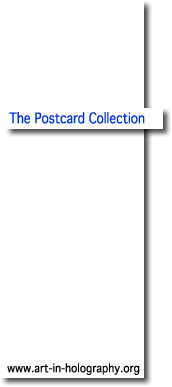

I once called holography 'a stiff medium', and that still seems a good
description of it from a creative point of view. 'Stiff' in the sense that
it requires a great deal of pre-planning, major technical resources, a
logical, step-by-step approach in order to achieve the desired result.Because it has a certain kinship to photography, the temptation is to see
it as an extension of the photographic way of doing things. Speaking as
someone who uses a camera a great deal, I think the two media are entirely
different. Holography deals in three-dimensional forms. The relationship of
the form to the edge of the plate is not crucial - in fact, it shifts
according to the spectator's viewpoint. With photography, the contrary is
the case.Most of all, the two media have totally different attitudes to the notion
of verisimilitude. A photograph always shows an event in the past. It says:
'This happened - someone saw it'. Even knowing what we do now about
photographic trickery, we tend to accept this statement. A hologram says:
'This is happening - right now.' But we often feel a kind of scepticism.
The reality which is offered is not our reality, but something taking
place in a parallel universe.Edward Lucie-Smith spoke in the Critics' Forum
Edward Lucie-Smith, 1998
Black and white photograph
Photo © Edward Lucie-Smith
